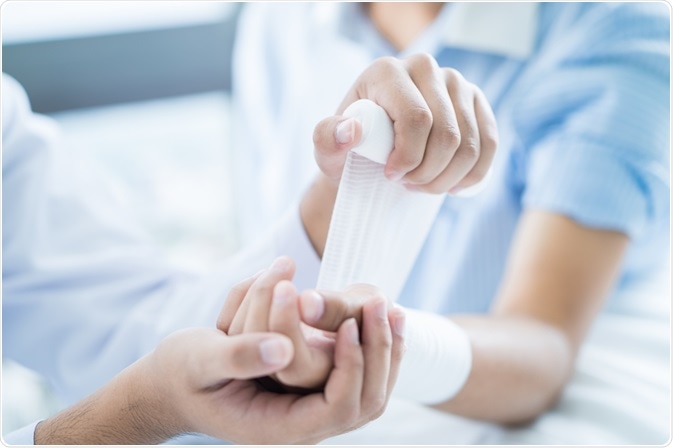Bioactive glass implants are commonly used in orthopedics and dentistry as they can form strong and direct bonds with bone. The capability of bioactive glass to stimulate the growth of new blood vessels also makes them ideal for wound healing.
 Image Credit: PORTRAIT IMAGES ASIA BY NONWARIT / Shutterstock
Image Credit: PORTRAIT IMAGES ASIA BY NONWARIT / Shutterstock
What is Bioactive Glass?
Bioactive glasses are a group of surface-reactive glass-ceramic biomaterials. The first bioactive glass was developed in 1969 by Larry L. Hench at the University of Florida.
This material was formed using silicate glass in order to enhance the mechanical and bioactive properties needed for applications in bone regeneration.
Since then, many different types of bioactive glass have been developed, with specific compositions and properties targeting certain medical uses.
These range from glasses made from borate, which are valuable due to their high dissolution rates, to glass implants made from phosphate which demonstrate higher solubility when in contact with biological fluids.
The most commonly used medical products based on the original proprietary bioactive glass are used as implant devices to repair or replace calcified tissues, such as bone and enamel.
The very first application of a bioactive glass, which dates back to 1984, was used to repair the ossicular chain of the middle ear of a patient who became deaf after an infection.
Another bioactive glass, which has been approved by the FDA, is used for the regeneration of the jaw bone in periodontal disease.
Bioactive glass was traditionally designed for these uses as it forms a bond with the host tissue (typically bone) by establishing an interfacial layer of calcium phosphate.
However, when it became possible to alter the composition and hence the properties of bioactive glass, recent research has focused on making bioactive glass implants highly useful for applications in the healing and replacement of soft tissues.
The Benefits of Bioactive Glass
The process of wound healing
Extraordinarily, the human body can heal itself after suffering even extreme trauma. However, this is a complex biological process, and, if great amounts of tissue have been lost, tissue engineering may be required to provide a temporary biomaterial scaffold for support and to encourage the right structure while the new tissue develops.
During this healing process, it is crucial for new blood vessels to regenerate from pre-existing ones; this physiological process is termed angiogenesis.
The nutrients delivered by the new growing blood vessels are vital in repairing damage and aiding the growth of new tissue.
There is substantial in vivo and in vitro evidence that bioglass products have an angiogenic effect by secreting angiogenic growth factors.
This means that once implanted in the body, bioactive glass can act as a scaffold for wounds, while bonding with existing tissue through calcium-rich bonds and aiding the growth of new tissue through vascularization.
Bioactive glass and tissue regeneration
The skin can be badly damaged by injury, disease or a chronic wound. In such cases, it is of the utmost importance to repair the damaged tissue while preventing infection and also eradicating excessive fluid exudates to ensure satisfactory healing.
In addition to the pro-angiogenic demonstrations of bioactive glass products, these materials also exhibit antibacterial effects making them ideal for wound healing.
Bioactive glass products used for wound care include nanofibrous bioactive glass dressings and ointments containing bioactive glass particles. Many different compositions have proved successful in accelerating the process of wound healing and enhancing the quality of new tissue.
The success of a novel bioactive glass formed from borate was demonstrated in a clinical trial held in 2011.
In this study, pads made from the glass fiber material were administered to patients suffering with problems associated with venous stasis, a condition where blood circulation in the extremities is poor.
As the blood pools, typically in the lower legs, extracellular fluid accumulates, increasing pressure on the skin and causing long-term wounds.
Bioactive glass dressings accelerate the speed of wound healing in this situation, as was shown in almost two-thirds of the participants, in addition to avoiding the development of scar tissue on the skin.
The ease of use and low-cost nature of bioactive glass products suggests that they could also be very useful in the healing of more extensive wounds, such as burns.
Further Reading